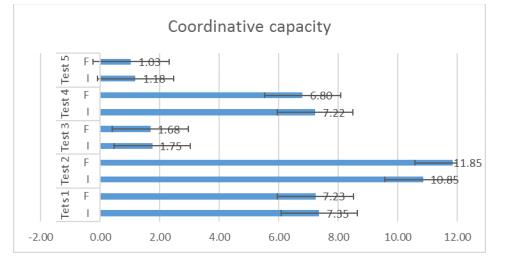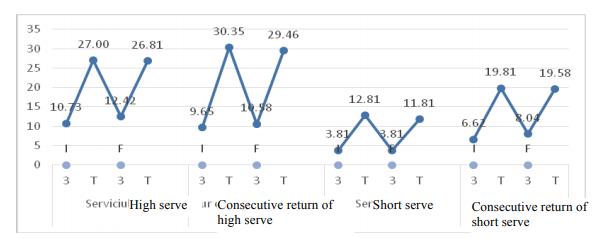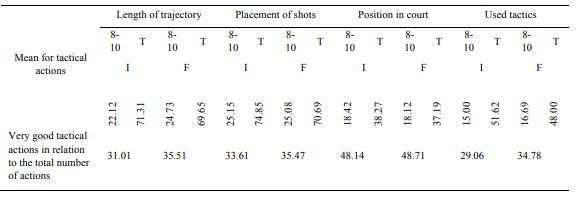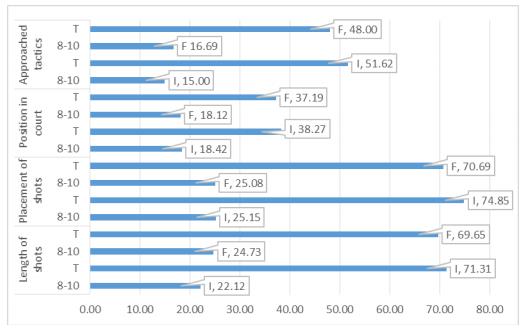Abstract
First appeared at the Olympic Games in Munich 1972 as a demonstration sport, badminton has the ability to attract a large number of practitioners because of the ease with which a beginner can perform ball exchanges with his/her partner. The role of the coach is to use motivation to make the beginners progress. Designing effective training programs for junior badminton practitioners aims to provide individual evolution opportunities regarding the sport- specific techniques and tactics. The purpose of our research is to identify means of personalized intervention that will increase the performance capacity in badminton. Evaluation of techniques used by athletes showed an increase in the number of excellent executions between the two tests and a decrease in the total number of executions. This is nothing but an increase in the quality of the techniques used. The results achieved by the 26 athletes highlight that applying an optimized training program through means aimed to develop the coordination capacity has led to an increased capacity of performance in juniors, ranking them among the top athletes in the national championship for under 15 and 17 years of age.
Keywords: Badminton; coordination capacities, performance, juniors
1. Introduction
A duel sport, badminton also involves the performance evaluation of athletes, and our scientific
approach includes the determination of the level reached by practitioners as a result of completing a
training and educational process in terms of both competition and effectiveness of the training
program.
Designing training programs for junior badminton practitioners aims at providing them with
individual opportunities for continued progress with respect to the fundamentals of the techniques and
tactics specific to this sport. In developing a training program, it is necessary to consider a number of
pedagogical issues, such as tracking individual progress, differentiating training based on individual
peculiarities, and the question or principle of intuition (Larsen, 2010: 18). Therefore, the concepts
proposed to be acquired must be consistent with the training level of athletes, while the complexity of
exercises will gradually increase with the acquiring of the current level.
Designing a training program allows athletes to rediscover the role of technical tools in the tactics of
the game. The complexity of planning is reflected by the different coordination possibilities of athletes
and also by the degrees of freedom in the involved joints when using different strokes in both training
and competition (Sorensen, de Zee, & Rasmussen, 2011: 625-626).
For this purpose, the athlete will place each execution in a logical structure that leads to scoring the
point. Thus, the player should consider the following for each point he/she can play (Leveau, 2005:
31):
the technical elements and procedures that he/she knows; the conditions in which these procedures are highly effective; the partner’s constant and momentary characteristics (motor and energy, information, decision-
making, psychological and emotional features);
the tactical strategies required by the rules of the game.
Our experience has shown us that when the junior player begins to discover this discipline, he/she
already has general motor skills that are immediately translated into badminton-specific motor skills.
Any newly acquired skill will change everything the athlete already knows. For example, the player is
able to receive and hit a moving object with or without footwork, which makes it easy to hit the
badminton shuttlecock.
Consequently, the role of the coach is to intervene in order to enable the athlete to integrate the new
skills and to acquire new motor behaviours. Such intervention should be progressive and it should be
kept in mind that in the absence of bilateral games, competitions, individual or team defeats, learning
new elements will be boring, lacking any enthusiasm.
During their game, athletes exhibit comparable behaviours, which gives us the possibility to
describe four underlying components of physical activity (balance, separation of body positions and
segments, continuous information, tactical representation) (Grunenfelder & Couartou, 2001: 42). Each
of them is involved in the generation of trajectories and the player’s behaviour at the time of execution,
on the one hand, and in the coordination between the player’s movements and shuttlecock hitting, on
the other hand.
A study on 9-13 years old tennis players has revealed that kinaesthetic differentiation and reaction
ability, as coordination components, are the most important abilities in tennis (Tsetseli et al., 2010).
The same authors found that a supplementary coordination program in addition to tennis training
improved significantly the service technique. Previous studies also suggested that training coordination
abilities in childhood improved performance in racquet sports (Abernethy, 1988; Druckman & Swets,
1988), along with technical skill development (Kambas et al., 2003)
2. Materials and methods
Our ascertaining and formative experiment study was conducted over a period of nine months, from
April to December. Throughout this time, we conducted initial and final tests with respect to the
coordination ability and the technical procedures and tactical actions used by the athletes along with
studying specific literature. We also used exercises dedicated to the development of coordination
abilities alongside other training means specific to badminton during that time.
While attending our training program, the school club athletes participated at the same time in the
competitions organized by the Romanian Badminton Federation, where they achieved outstanding
results. The rating of the athletes included tests to determine the coordination capacity and notes on
matters regarding the technical procedures and tactical actions applied by the players.
The guided observation helped us to determine their performance capacity, the athletes being
evaluated in the bilateral games held during practice. We were able to measure the technical procedures
and tactical actions used by the athletes with the help of video recordings as well.
Moreover, the place occupied in the overall ranking of the national badminton competition, as may
be seen on the Romanian Badminton Federation’s website, is a further relevant indicator of the juniors’
performance capacity.
The location of the evaluation and training programs was the sports hall of the School Sports Club
no. 6 in Bucharest. In addition to that location, the athletes also benefited from a one-week training
camp in Năvodari.
In analysing data for the present study, we used Microsoft Office Excel, and as statistical indicators
we rated the arithmetical mean, the Pearson correlation, along with the Student t-test.
2.1. Hypothesis
The implementation of an optimized training program comprising means to develop coordination
capacity will lead to increased performance capacity of juniors and their ranking among the top athletes
under 15 and under 17 years of age in the national championship.
2.2. Participants
Our test subjects were members of the School Sports Club no. 6 in Bucharest, affiliated to the
Romanian Badminton Federation. They participated in our training program and in the initial and final
tests. 26 juniors, namely 14 girls and 12 boys, aged between 14 and 16 years, took part in our study.
2.3. Methods
As regards the determination of the level of coordination capacity, we conducted 5 tests as follows
(Amar, 2003: 35):
Test 1. Shuttle run between numbered medicine balls – determining the athletes’ orientation capacity
Test 2. Throwing the medicine ball back – determining the kinaesthetic differentiation capacity Test 3. Motor reaction test – determining the motor reaction capacity
Test 4. Balanced walk on the balance beam – determining the balance capacity Test 5. Running at a given rhythm – determining the rhythm capacity
The performance capacity was rated during a singles match (Amar, 2003: 59-66). The rating scale
was from 0 to 3 for each of the elements below (Table 1).
We used the summary table below (Grunenfelder & Couartou, 2001: 146) to rate the tactical aspects
(Table 2).
3. Results
After having summarized the results obtained in the rating of the coordination capacity, we were
able to notice a decrease in the arithmetic mean of the results recorded in the tests where the units of
measurement were the seconds and meters. In the test where the medicine ball was thrown back and
where the unit of measurement was expressed as points, the results of the arithmetic mean showed a
growth in values. All such results pointed out an increased coordination capacity between the two tests
(Fig. 1). Regarding the coefficient of variation in the tests aimed at the coordination capacity, we found
a great homogeneity in three of the tests and a moderate one in the other two. With a view to validating
our training program comprising coordination ability development components, we used t-test to
determine the statistical significance of the results.

We applied t-test to identify the existence of the statistical significance between the two ratings
(Table 3). In test 1 involving shuttle runs between numbered medicine balls, the calculated t-value was
2.48, while the critical t at (n-1) in Fisher’s table was 2.05. The calculated t-value was higher than the
critical t, thus the results could not be due entirely to chance, and so there was a statistically significant
difference between the two means.
In tests 3, 4 and 5, the calculated t-value was 4.10, 3.58 and 3.65 respectively in relation to the same
critical t-value of 2.05, which rendered evident a statistically significant difference between the initial
and final testing.
In the medicine ball throw test, the calculated t-value was lower than the critical t at (n-1) for p<
0.05, which did not confirm a statistical significance of the difference between the 2 tests. An average
correlation was determined for this test, as the Pearson coefficient was 0.57.
In the other tests, the Pearson correlation coefficient ranged from 0.76 to 0.96, thus showing a high
and very high correlation.
The rating of the technical procedures used by the athletes highlighted an increase in the number of
excellent executions between the two tests and a decrease in the total number of executions (Table 4).
This merely showed an increase in the quality of the technical procedures used. The improved technical
skills of the players were due to their training process.
As to the high serve, the quality of the training process resulted from the ratio of excellent
executions to total number of executions that increased from 39% to 46% between the two ratings (Fig. 2).

in the initial rating and increased to 48% after the final rating (Table 5).
There were also increases in the mean values recorded for the other technical procedures analysed;
those that stood out were the lob values, where the variation went from 15.31 to 17.81, and the
backhand values, where the difference between the initial and the final rating was 2.42 shots in favour
of the latter (Fig. 3).
There was lower variation in the drop shot between the initial and final testing, but we noticed a
decrease by 3 units in the total number of executions of this kind, reinforcing the idea of improved
performance capacity of athletes as a result of completing the training process.

The tactical actions used by the athletes confirmed the trend seen from the analysis of the technical procedures (Fig. 4). Therefore, an increase was recorded in the use of very good tactical actions between the two tests, accompanied by a growing percentage of tactical successes in relation to the total number of actions (Table 6).

The alternative use of long shots, drop shots and shots of various heights reached 35% after
completing the training program, whereas the percentage determined in the initial testing was 31%.
Regarding the placement of executions, we noticed a 2% growth in the use of shuttle shots to the
four corners of the court in the final rating compared to the first rating.

The only situation where we found a stable ratio of very good actions to total number of actions was
the one referring to the position in court, where the percentage was 48% in both tests.
The approached general tactics also experienced an increase in percentages from 29% to 34%,
showing that the players’ game was faster and more combinatory at the end of the year.
4. Discussions and conclusions
Designing efficient training programs for junior badminton practitioners provides individual
opportunities for continued progress with respect to the sports training components. The training and
ratings emphasized the development of the coordination capacity and performance capacity of 26
junior athletes of the School Sports Club no. 6 in Bucharest.
The rating of the coordination abilities showed a variation of homogeneity from moderate to high,
with values ranging from 9% to 28% in the initial testing and from 8% to 25% in the final testing. The
analysis of the arithmetic mean of the results obtained in the rating of the coordination capacity
revealed a growth in the coordination abilities between the two tests. By introducing a training program
comprising a coordination ability development component, we achieved statistically significant results
given that in 4 of the 5 tests the calculated t-value was higher than the critical t, and that the players’
progress could not be due entirely to chance.
The technical procedures subject to evaluation showed an increase in the ratio of excellent
executions to total number of shots from 40% to 48% for the smash, or from 39% to 46% for the high
serve. The technical procedures analysed also recorded increased mean values, the most remarkable
being the lob values, where the variation was from 15.31 to 17.81, or the backhand values, where the
difference between the initial and the final rating was 2.42 executions in favour of the latter.
As for the tactical actions, there was an increase in the use of a fast and combinatory game in the
context of setting the pace of the play between the two tests and increasing the ratio of tactical
successes to total number of actions at the same time. The results of the 26 athletes in the national
competitions included winning the first four places in men’s singles, doubles and mixed doubles for
under 17 years of age, the 3rd place in men’s mixed doubles for under 15 years of age and the 4th place
in women’s singles and doubles for under 17 years of age.
Considering the above, the implementation of an optimized training program comprising means to
develop the coordination capacity led to increased performance capacity of juniors and to their ranking
among the top athletes under 15 and under 17 years of age in the national championship, which means
that our hypothesis is supported by the findings.
Therefore, bringing the training programs up to date should be a constant endeavour in order to be
able to provide future badminton professionals with practical solutions and to draw a large number of
practitioners of this sport.
From the point of view of the badminton coach, each element of the player’s behaviour should be
seen as condition or consequence of the other elements, which implies that the approach to the
planning of activities should consider the players’ individual characteristics. The little information on
the role of coordination capacities in badminton, the sample size used in the research and the inability
to increase the number of practices are constraints that can influence the effectiveness of the training
program.
References
Abernethy, B. (1988). The effects of age and expertise upon perceptual skill development in a racquet sport.
Research Quarterly for Exercise and Sport, 59(3), 210-221.
Amar, K. M. (2003). Relationship of coordinative abilities to performance in badminton (Master Thesis).
Lakshmibai National Institute of Physical Education.
Druckman, D., & Swets, J. A. (Eds.). (1988). Enhancing Human Performance: Issues, Theories and
Techniques. Washington: National Academy Press.
Grunenfelder, F., & Couartou, G. (2001). Badminton. De l`école… aux associations. Paris: Revue EPS. Kambas, Α., Fatouros, J., Aggelousis, Ν., Gourgoulis, V., & Taxildaris, Κ. (2003). Effect of age and sex on the coordination abilities in childhood. Inquiries in Sport & Physical Education, 1, 152-158.
Larsen, K. (2010). Badminton Europe Coach Education (2nd edition). Broendby: Badminton Europe. Leveau, C. (2005). LeBadminton en situation. Observer et intervenir. Paris: Revue EPS.
Sorensen, K., de Zee, M., & Rasmussen, J. (2011). A biomechanical analysis of clear strokes in badminton executed by youth players of different skill levels. Brussels : International Society of Biomechanics Congress XXIII.
Tsetseli, M., Malliou, V., Zetou, E., Michalopoulou, M., & Kambas, A. (2010). The effect of coordination training program on the development of tennis service technique. Journal of Biology of Exercise, 6(1), 29-36.
Copyright information

This work is licensed under a Creative Commons Attribution-NonCommercial-NoDerivatives 4.0 International License.
About this article
Publication Date
10 June 2016
Article Doi
eBook ISBN
978-1-80296-010-5
Publisher
Future Academy
Volume
11
Print ISBN (optional)
-
Edition Number
1st Edition
Pages
1-509
Subjects
Sports, sport science, physical education
Cite this article as:
Timofte, D., & Titu, A. (2016). Study Regarding the Relationship between Coordination and Performance Capacity in Badminton. In V. Grigore, M. Stanescu, & M. Paunescu (Eds.), Physical Education, Sport and Kinetotherapy - ICPESK 2015, vol 11. European Proceedings of Social and Behavioural Sciences (pp. 226-234). Future Academy. https://doi.org/10.15405/epsbs.2016.06.31

